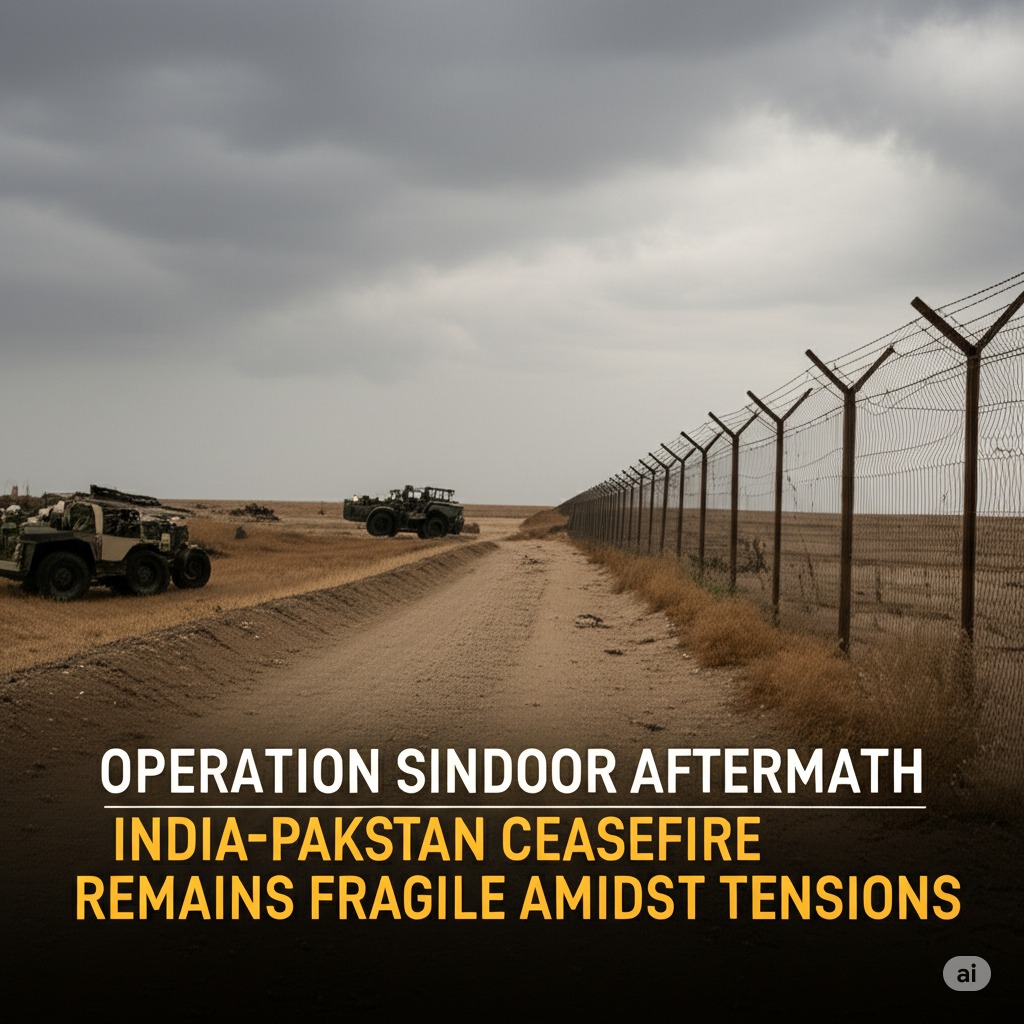Operation Sindoor Aftermath: India-Pakistan Ceasefire Remains Fragile Amidst Tensions
Published on May 24, 2025 | Generated by AI
 🤖 AI-generated Image
🤖 AI-generated Image
Why It Matters
Tensions between India and Pakistan have escalated significantly following the deadly terror attack in Pahalgam, Jammu and Kashmir, on April 22, 2025, which resulted in the deaths of 26 civilians, including Indian tourists and one Nepali citizen. This attack triggered a strong response from India, elevating the long-standing friction between the two nuclear-armed neighbors to a critical level. The incident underscored the persistent security threats emanating from across the border and their profound impact on the safety and lives of civilians in the region, as well as the broader geopolitical stability of South Asia. The Pahalgam attack served as a direct catalyst for India to recalibrate its counter-terrorism posture and response mechanisms.
Background & Timeline
In the immediate aftermath of the Pahalgam attack, India reacted forcefully at diplomatic and security levels. The government granted armed forces full operational freedom to respond, signaling a shift towards a more assertive stance against cross-border terrorism. Simultaneously, India condemned Pakistan at international forums, labeling it a "rogue state" for its alleged support of terrorist groups. Security was heightened across Jammu and Kashmir, leading to the closure of numerous tourist destinations and reports of precautionary movements by the Pakistani military, including radar systems, near the border. This period saw increased vigilance and anticipation of an Indian response, building the backdrop for subsequent military actions.
What’s Happening Now
-
Following the heightened tension, the Indian Armed Forces launched "Operation Sindoor" on May 7. Described as precision strikes, the operation targeted nine alleged terrorist infrastructure sites across Pakistan and Pakistan-occupied Kashmir (PoK), linked to groups like Jaish-e-Mohammed (JeM), Lashkar-e-Taiba (LeT), and Hizbul Mujahideen. India claimed the strikes resulted in numerous casualties among terrorists and were deliberately non-escalatory, focusing solely on terror infrastructure while avoiding Pakistani military targets. Pakistan confirmed the strikes, reporting casualties and condemning the action as an "act of war," vowing retaliation.
Pakistan responded with artillery fire along the Line of Control (LoC) and initiated drone and missile attacks targeting areas in Jammu and Kashmir, Punjab, and Rajasthan. India reported repelling these attacks using its air defense systems, including the S-400. The escalation led to significant disruptions, including the temporary closure of numerous airports across northern and western India, widespread flight cancellations, and precautionary blackouts in border districts.
Amidst escalating military actions, Pakistan initiated contact, leading to an agreement for an immediate ceasefire effective May 10th at 5 pm. While the US claimed mediation, India asserted the ceasefire was established on its own terms, maintaining its firm stance against terrorism and confirming the Indus Waters Treaty suspension remains in abeyance. However, reports of ceasefire violations, including explosions in Srinagar and drone intrusions, emerged shortly after the truce took effect, raising concerns about its fragility. India's External Affairs Minister S Jaishankar reiterated that India's position on terrorism remains unchanged and future terror acts will be considered acts of war, conditioning any dialogue with Pakistan on addressing terrorism and the return of PoK.
What Could Happen Next
-
1. Tense, Conditional Ceasefire Continues: The current state of a fragile ceasefire, marked by mutual suspicion and occasional low-level incidents, persists. Direct communication channels between the Directors General of Military Operations (DGMOs) are utilized to manage immediate violations and prevent significant escalation. International calls for restraint continue, potentially leading to cautious confidence-building measures, but underlying issues like cross-border terrorism and territorial disputes remain unresolved, keeping tensions high.
2. Return to Increased Border Hostilities: Despite the ceasefire agreement, persistent violations and unresolved grievances lead to a breakdown of the understanding. This could result in a return to regular cross-border shelling, increased infiltration attempts, and potentially renewed targeted strikes by India if provoked by significant terror attacks. The situation along the LoC and International Border becomes volatile again, disrupting civilian life in border areas and increasing the risk of miscalculation.
3. Further Escalation and Wider Conflict: A major security incident, such as a large-scale terrorist attack with significant casualties or a direct military confrontation resulting in substantial losses, could trigger a severe escalation. This scenario involves the potential for wider military engagement beyond border skirmishes, possibly drawing in advanced weapon systems and increasing the risk of a full-blown conflict with devastating consequences for the region. International intervention efforts would likely intensify but might struggle to contain a rapidly deteriorating situation.
This article is generated using AI-assisted summaries and verified timelines.
